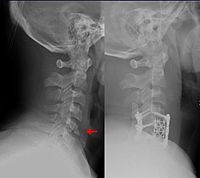
Photo from wikipedia
Background The rates of opioid abuse and overdose in America have risen in parallel with the rates of opioid prescribing by physicians. As such, we sought to examine the prescribing… Click to show full abstract
Background The rates of opioid abuse and overdose in America have risen in parallel with the rates of opioid prescribing by physicians. As such, we sought to examine the prescribing practices among plastic surgery attendings and trainees to determine the need for more thorough education. Methods A survey was distributed to all ACGME-accredited plastic surgery residency programs and included questions regarding opioid-prescribing practices and self-rated ability pertaining to opioid management. Trends in prescribing practices based on prescriber position were analyzed using cumulative odds ordinal logistic regression with proportional odds and Chi-squared tests for ordinal and nominal variables, respectively. Results We received 78 responses with a wide geographical representation from plastic surgery residency programs: 59% of respondents were male and 39.7% female, 29.5% were attendings, 26.9% senior residents, 29.5% junior residents, and 14.1% interns. Compared with attendings, interns prescribe fewer pills ( p < 0.05) and were significantly more likely to prescribe oxycodone ( p < 0.03). Junior residents were 4.49 times more likely ( p = 0.012) and senior residents 3.65 times more likely ( p = 0.029) to prescribe additional opioids to avoid phone calls and follow-up visits. Interns and senior residents were significantly less comfortable than attendings in managing patients requesting additional opioids ( p < 0.02). Conclusions The results of this survey demonstrate that knowledge deficits do exist among trainees, and that trainees are significantly less comfortable than their attending counterparts with opioid prescribing and patient management. Therefore, the implementation of a thorough postoperative pain management education in residency may be a cogent strategy in mitigating the opioid crisis. Level of Evidence III This journal requires that authors assign a level of evidence to each article. For a full description of these Evidence-Based Medicine ratings, please refer to the Table of Contents or the online Instructions to Authors www.springer.com/00266 .
Journal Title: Aesthetic Plastic Surgery
Year Published: 2020
Link to full text (if available)
Share on Social Media: Sign Up to like & get
recommendations!